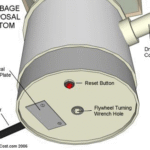You’re standing in your kitchen, ready to tackle a mountain of dishes, and suddenly, your trusty GE dishwasher refuses to turn on. Frustration sets in as you wonder what could possibly be wrong.
Is it a simple fix, or should you brace yourself for a costly repair? You’re not alone in this moment of appliance anxiety. Many homeowners face this hiccup, and the good news is, there are practical steps you can take to get your dishwasher back up and running.
We’ll explore common reasons why your GE dishwasher might not be turning on, along with straightforward solutions you can try today. So, before you call in the professionals, let’s dive into the troubleshooting steps that could save you time, money, and a whole lot of hassle.

Credit: theappliancecarecompany.com
Common Causes Of Power Issues
Have you ever faced the frustration of your GE dishwasher refusing to turn on? You’re not alone. Many people encounter power issues with appliances, and understanding the common causes can save you time and effort. Let’s dive into some typical reasons why your dishwasher might be having trouble powering up.
Faulty Power Supply
The power supply is the lifeline of your dishwasher. If it’s compromised, your appliance won’t work. Have you checked if the dishwasher is plugged in properly? Sometimes, a loose connection is all it takes to cause a hiccup.
Another thing to consider is the cord itself. Is it damaged or frayed? A worn-out power cord can be a silent culprit. By inspecting these details, you could identify a simple fix and get your dishwasher running again.
Tripped Circuit Breaker
Imagine this scenario: you load your dishwasher, press start, and nothing happens. You might immediately think the dishwasher is broken, but hold on! Check your home’s circuit breaker first.
Sometimes, the breaker trips due to overload or a power surge. Resetting it is quick and easy. Have you ever thought a major repair was needed, only to find the solution was as simple as flipping a switch?
Defective Outlet
A faulty outlet can be the cause of your dishwasher’s refusal to turn on. Plugging another device into the same outlet can help you determine if it’s the problem. If the other device fails to power up, you’ve found your issue.
Does your outlet feel warm or smell unusual? These can be signs of a defective outlet, which might need replacement. Addressing this quickly can prevent bigger electrical issues in your home.
Power issues can be straightforward to solve once you pinpoint the cause. Have you tried these fixes yet? Share your experiences and see if others have faced similar challenges. Solving these problems might be more accessible than you think!
Checking The Power Cord And Plug
Is your GE dishwasher not turning on? Let’s start by checking the power cord and plug. This simple step can sometimes resolve the issue. An overlooked cord or connection might be the culprit. Inspecting the cord can help determine the problem.
Inspecting For Damage
First, look at the power cord for any visible damage. Check for cuts or frays in the wire. Damaged cords can prevent electricity from reaching your dishwasher. Feel for any bumps or bends that might indicate internal damage. If the cord is damaged, consider replacing it.
Ensuring Proper Connection
Next, check if the plug is securely connected to the outlet. A loose plug can interrupt the power supply. Push the plug firmly into the socket. Ensure it fits snugly and does not slip out easily. If the outlet seems faulty, try another one. Sometimes outlets wear out and need replacement.
Evaluating The Control Panel
Understanding why your GE dishwasher isn’t turning on can be frustrating. Start by evaluating the control panel. This area is crucial for diagnosing issues. Faulty settings or buttons often cause malfunction. Knowing the common problems can help you troubleshoot effectively.
First, assess the control panel for any visible signs of damage. Check if the display lights are active. This can indicate whether power is reaching the unit. A blank display may signal a deeper electrical issue. Inspect closely for any cracks or wear.
Locked Control Settings
The control settings might be locked. This prevents the dishwasher from starting. Check if the lock indicator is illuminated. If so, unlock the settings. Press and hold the lock button for three seconds. This often resolves the issue. Be sure to consult your user manual if unsure.
Sometimes, the control panel gets locked unintentionally. Children or pets might tamper with buttons. Always ensure the lock feature is off before starting a cycle. Regular checks can help avoid confusion in the future.
Malfunctioning Buttons
Malfunctioning buttons can hinder the dishwasher from turning on. Inspect each button for responsiveness. Press lightly to test their functionality. If a button feels stuck, it might need cleaning. Dust or debris can accumulate over time.
Consider using a soft brush or cloth. Gently clean around the buttons. This can improve their performance. Persistent issues might require professional assistance. Faulty buttons often need replacement by an expert. Regular maintenance can prevent recurring problems.
Assessing Door Latch Problems
Experiencing issues with your GE dishwasher not turning on? The problem might lie in the door latch. A malfunctioning latch prevents the dishwasher from operating, as it cannot signal the appliance to start. Assessing and fixing the latch could be the key to resolving this common issue.
If your GE dishwasher isn’t turning on, the issue might be as simple as a door latch problem. The door latch acts as a safety mechanism, ensuring the appliance only operates when securely closed. A malfunctioning latch can prevent the dishwasher from starting, leading to unnecessary frustration. By understanding and addressing door latch problems, you might save yourself from costly repairs or replacements.Testing Door Latch Functionality
Begin by checking if the door latch is properly engaging. You can do this by gently closing the dishwasher door and listening for a clicking sound. This click indicates that the latch has engaged properly. Sometimes, debris or food particles might obstruct the latch, preventing it from closing. Clean the latch area with a damp cloth to ensure nothing is blocking it. You’d be surprised how often a small crumb can cause such a big issue. If the latch still doesn’t click or feels loose, consider testing its alignment. A misaligned latch won’t engage properly, making the dishwasher think the door is open. Adjusting the door or latch slightly can often solve the problem.Repairing Or Replacing Latch
If testing reveals a faulty latch, you might need to repair or replace it. First, unplug the dishwasher to ensure safety. Then, remove the inner door panel to access the latch assembly. Inspect the latch for visible damage. Broken or bent parts usually indicate that a replacement is necessary. You can purchase a new latch assembly at most appliance stores or online. Replacing the latch might sound daunting, but it’s a straightforward process. Follow the manufacturer’s instructions, or consider watching online tutorials for step-by-step guidance. If you’re not confident in doing it yourself, hiring a professional might be the best option. Have you ever faced a similar issue and managed to fix it yourself? It’s empowering when you can tackle these repairs independently. Addressing door latch issues not only solves the immediate problem but also enhances your understanding of your dishwasher. Knowing how to assess and fix such problems can extend the life of your appliance, saving you money and hassle in the long run.Investigating Internal Fuse Issues
Experiencing a GE dishwasher not turning on can be frustrating. Investigating internal fuse issues might uncover the root of the problem. Checking the fuse is a simple step that ensures the dishwasher receives power.
Having your GE dishwasher refuse to turn on can be frustrating, especially when you’re faced with a pile of dirty dishes. One common cause could be an internal fuse issue. Think of the fuse as a safety feature that protects your dishwasher from electrical overloads. If it’s blown, your dishwasher won’t turn on. So, what’s the next step? Understanding how to locate and replace the fuse can save you time and potentially costly repair bills.Locating The Fuse
Your first task is to find where the fuse is located in your GE dishwasher. Most dishwashers have the fuse behind the control panel or near the circuit board. To get to it, you may need to remove a few screws and carefully lift the panel out. It’s a bit like a treasure hunt—without the map! Always make sure the dishwasher is unplugged to avoid any electric shock. Once you’ve located the fuse, take a moment to inspect it. If it looks burnt or damaged, it’s time for a replacement.Replacing A Blown Fuse
Replacing a blown fuse is simpler than you might think. Begin by purchasing the correct fuse for your specific GE dishwasher model. Having the right part is crucial—think of it like fitting the right key to a lock. Next, remove the damaged fuse gently with a pair of pliers or your fingers. Insert the new fuse in the same position, ensuring it’s snug and secure. Plug your dishwasher back in and test it. Hearing that hum of operation can feel as rewarding as finishing a marathon. If your dishwasher still doesn’t turn on, you may need to explore other issues. But fixing that fuse could very well have been the key to restoring your dishwasher’s functionality. Have you ever tackled a home repair you thought was out of your league? It’s amazing how a little guidance can turn you into a DIY hero!
Credit: www.youtube.com
Examining Water Supply Concerns
Water supply issues can cause a GE dishwasher to not turn on. A blocked or disrupted water line might be the problem. Checking connections and ensuring a steady flow can help resolve this common appliance concern.
When your GE dishwasher refuses to turn on, it can be frustrating. One often overlooked area is the water supply. Without a steady flow of water, your dishwasher can’t function. Ensuring the water supply is working properly might be the key to solving the issue. Let’s dive into some practical steps you can take to examine potential water supply concerns.Checking Water Valve
The water valve controls the flow of water into your dishwasher. If it’s not open, your dishwasher won’t receive water. Ensure the valve is fully open. It’s usually located under your kitchen sink. If you’re unsure which valve, look for the one connected to the dishwasher’s water line. A friend once discovered her dishwasher’s water valve was only partially open. After adjusting it, the dishwasher started working perfectly. Could this be your dishwasher’s issue too?Verifying Water Connection
Sometimes, the water connection itself might be the problem. Check the hose that connects your dishwasher to the water supply. Make sure it’s not kinked or blocked. A bent hose can restrict water flow, causing your dishwasher to malfunction. Inspect the hose for any signs of wear or damage. Replacing a damaged hose is a simple fix that can save you from costly repairs later. Is your water connection in good shape? Examining these water supply concerns might solve your dishwasher dilemma. Remember, small issues like these can often be fixed easily and without professional help. Have you checked your water supply today?Resetting The Dishwasher
A dishwasher that won’t turn on can be frustrating. Before you call a professional, try resetting it. Resetting can solve many common problems. Sometimes, it’s just a minor glitch. Resetting can clear these issues and get your dishwasher running again.
There are two methods to reset a GE dishwasher. One uses the reset button. The other is a manual reset procedure. Let’s explore both methods to help you get your dishwasher working.
Using Reset Button
Many GE dishwashers have a reset button. This button can be found on the control panel. Press and hold it for 3 seconds. You might hear a beep or see lights flash. This indicates the dishwasher is resetting. Wait a few minutes. Then, try to start the dishwasher again.
Manual Reset Procedure
If your dishwasher lacks a reset button, try a manual reset. Start by turning off the power supply. You can do this by unplugging the dishwasher. Or, switch off the circuit breaker. Wait for about 5 minutes. Then, restore the power. This can help reset the dishwasher’s system. Try starting the dishwasher once more.

Credit: www.reddit.com
Seeking Professional Help
Facing a GE dishwasher that won’t turn on can be frustrating. Professional help ensures accurate diagnosis and repair, saving time and stress. Trust experts to handle complex issues efficiently and restore functionality.
When your GE dishwasher refuses to turn on, it can be frustrating. Troubleshooting common issues might solve the problem. But sometimes, expert help is needed. Professional service ensures accurate diagnosis and repair. This can save you both time and money.When To Call A Technician
Some issues require professional expertise. If the dishwasher has no power, it might be an electrical problem. Unusual noises or leaks also signal deeper issues. A technician can identify these problems quickly. They have the right tools and knowledge. If you’re unsure about the problem, it’s best to consult an expert. Safety is a priority.Choosing The Right Service
Selecting the right service is important for resolving issues. Look for certified technicians. They should have experience with GE appliances. Check reviews and ratings online. This will help in finding reliable services. Ask about warranty on repairs. This ensures peace of mind for future issues. Compare quotes from different providers. This helps in getting fair pricing. `Frequently Asked Questions
Why Is My Ge Dishwasher Not Turning On?
There might be a power issue. Check the outlet and circuit breaker. Ensure the door is fully closed.
How Do I Reset A Ge Dishwasher?
Press the “Start/Reset” button. Wait two minutes. It should reset the dishwasher.
Could A Faulty Door Latch Cause Issues?
Yes, a faulty door latch prevents the dishwasher from starting. Ensure it’s securely closed.
What Role Does The Thermal Fuse Play?
The thermal fuse protects against overheating. A blown fuse stops the dishwasher from turning on.
Is The Control Panel Malfunctioning?
A malfunctioning control panel can stop operations. Inspect for visible damage or loose connections.
Conclusion
A malfunctioning GE dishwasher can be frustrating. Troubleshooting steps help identify the issue. Check power supply first. Inspect the door latch and control panel. Examine the motor and wiring connections. Regular maintenance prevents future problems. Clean filters and remove blockages frequently.
Professional repairs ensure safety and efficiency. Follow these tips to keep your dishwasher running smoothly. A functional dishwasher saves time and effort. Enjoy clean dishes without hassle. Stay proactive with regular checks and maintenance. Your kitchen routine will be seamless and stress-free.
Keep your appliance in top condition always.





